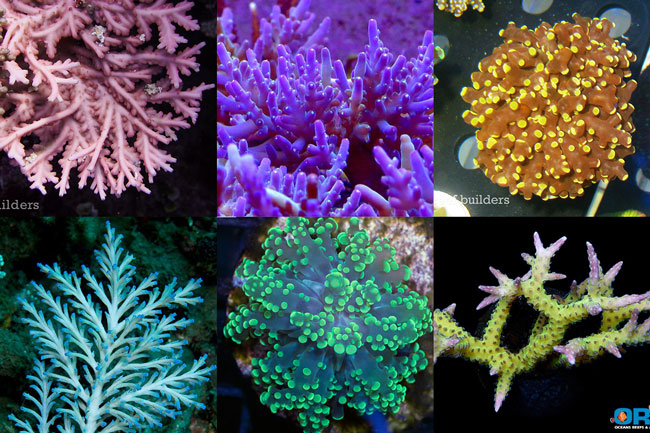The petition to list over 80 species of stony corals as endangered led to a ruling that 20 of the proposed corals were deemed threatened, and warrant protection under the Endangered Species Act. Of those 20 corals, five are Caribbean species which have already enjoyed a thorough degree of no-take protection so these species are of no concern to the aquarium hobby.
Nine more of the species deemed “threatened” are little known stony corals with limited distribution for which there exists very little information about natural abundance and range. But the remaining six species recently listed are ‘important” aquarium corals, most of which come to the aquarium hobby through sustainable harvesting and especially mariculture. You may not immediately recognize the latin names of these corals but we can assure you the entire hobby will get to know them really well if and when the 4(d) Provision is issued.
 The first major blow that the threatened coral ruling hands down to the SPS lovers is the listing of Acropora lokani. This is one of our all-time favorite species of Acropora that the reef hobby has been enjoying and propagating for well over a decade.
The first major blow that the threatened coral ruling hands down to the SPS lovers is the listing of Acropora lokani. This is one of our all-time favorite species of Acropora that the reef hobby has been enjoying and propagating for well over a decade.

Also known as the 20,000 leagues lokani, or 30,000 leagues lokani, this beautiful, delicate-branching stony coral is extremely colorful with a vivid purple color that is sometimes contrasted by a beautiful yellow or green interior color. Losing Acropora lokani from our beloved reef tanks would be an absolute shame and we consider this species one of the “poster-corals” that we’ll lose if a 4(d) provision is issued.

Of more immediate concern to the local and online stores that sell corals is the listing of Euphyllia paradivisa, the branching frogspawn. Since it is a branching species, E. paradivisa grows really fast and can easily be cultured in aquariums and in the sea.
The branching frogspawn is an easy beginner coral that is relatively hardy, and comes in some beautiful colors – green, orange, yellow and combinations of these colors on the tentacles and the tips is what keeps this species fresh in the aquarium hobby, not to mention it grows like a dang weed! In fact the first time we ever saw an orange frogspawn it was a branching E. paradivisa whose branches had been separated so that frags thereof could be shared and distributed to many different hobbyists.

The remaining three Acropora species that were listed as threatened are Acropora jacquelinae, A. tenella, and A. speciosa. These three species are of the ‘deepwater acro’ variety and are some of the prized species that are grown at coral farms throughout Indonesia. A limited number of Acropora jacquelinae are also farmed and collected for the aquarium hobby but the other two really constitute the eye-catching corals that will be sorely missed if they become banned.

Acropora speciosa is hands-down one of the most exquisite species of all Acropora. This deepwater style stony coral comes to us mostly as farmed specimens from Bali Aquarium and its potential as an aquarium coral has not yet been well established. Nevertheless, A. speciosa is one of the most coveted species of deepwater stony corals and if you already have a piece of this coral, be sure to grow it and share it with your reefing friends as we may not be able to import or trade in this coral at all in the future.

Acropora tenella is another deepwater acropora whose aquarium suitability has not yet been well established. If our original pictures from Kwajalein Atoll are any indication, this could be one of the nicest species of red Acros we’ve ever seen but due to the ruling we may never find out. Perhaps the biggest blow about the listing of A. tenella and A. speciosa is that these are two of the nicest species of stony corals in Kwajalein Atoll which are already in culture at a budding coral farm, but the threatened status coral listing could shut down this source of sustainable income before the coral farm ever has a chance to get off the ground.
The final species of coral listed as threatened that we should be concerned about is Seriatopora aculeata. S. aculeata is indeed a rare species of birdnest coral in the wild, but the aquarium hobby has been enjoying its own strain for like 15 years now, better known as the Ponape Birdnest.

This strain and species of birdnest coral comes to us almost exclusively from a single colony that was harvested in the Pacific Ocean and its progeny have reached far and wide, it can probably be found in tens of thousands of reef aquariums in America alone. The Ponape Birdnest is a mainstay of coral farmers everywhere and even ORA grows the Ponape Birdnest. It’s impossible to say for sure if the Ponape Birdnest is actually the threatened Seriatopora aculeata but due to its original collection location. The final call on whether this domesticated strain of stony coral is indeed S. aculeata will fall on the inspectors in ports across the country.
We hope that this brief overview of the stony coral species listed as threatened transforms a list of incomprehensible scientific latin jargon into real and tangible corals that we’ll miss if we get a 4(d) provision. These are REAL corals that are REALLY beautiful but if we are to safeguard these species in the aquarium hobby, the time is now to band together and fight the proposed legislation.



